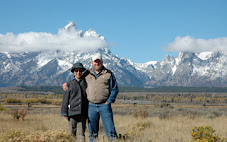
First of all, don't come on this road thinking it's only nine miles long. I drove about 85 miles from Wellington (just outside Price) to Myton (just outside Duchesne), of which about 20 miles were paved. The rest is well maintained gravel and dirt, but it can be a bit rough and slippery in spots. I brought home a ton of mud caked to my Tahoe from top to bottom. A car should have no trouble in the summer (I passed a Honda Element), but you might need new shocks when you're done.

The road was originally built to send supplies from the train stop in Price to soldiers at Fort Duchesne in the 1880s, and it became the most heavily traveled road in Eastern Utah during the late 1800s. There's even a story that the Wild Bunch planned to rob the soldiers' pay wagon and kill all 20 guards. Someone, possibly Butch Cassidy, tipped off the Army because, though he wasn't involved, he figured he'd be blamed and the Army would be relentless in its search of the murderers. So the Army doubled its guard, and the gang chickened out.

The main attraction along this road, which some call the "world's longest art gallery," is more than 1,000 rock art (petroglyph) sites with more than 10,000 individual drawings, a larger concentration than anywhere else in the world, according to Wikipedia.

Besides the Fremont Indians (and maybe others, including Utes), ranches, farms, and a town with post office, hotel for wagon travelers (it took six days to get from Price to Fort Duchesne), and store have occupied the land along this road.

Today these homes may not offer much protection, but the cows still think they're cool.

A few small ranches, cattle herds, and homesteads still dot the landscape.

This herd had 36 deer in it. I found that if I parked behind an old cow shed and crept very, very slowly, the deer would watch me but wouldn't run. I walked mostly in the shadow of the shed, then did a crouching walk up to and behind a wooden fence until I was pretty close.

Squatting on the balls of my feet, I lost my balance for a split second and swung my arm back to rebalance. That's all the deer needed as their signal to flee.

I'm guessing there were plenty of deer (or elk or big-horn sheep or pronghorns) during the Fremont Indians' stay here 800 and more years ago.

Guess what they call this rock. That's right, croquet ball. Just kidding. Did you say balanced rock? Ha ha. That's wrong. It's called Pig Head Rock.

I get the man leading the horse with a rider, but I'm not sure what the roundish thing is. A ball of fire, the moon, the sun?

What kind of animal is this? I think it's either a baby elephant or a dog that just ate a snake.

Probably not a problem this time of year, but there are snakes in this canyon, and apparently the Fremonts noticed them, too.

These indentations in the rock (if they look like bubbles to you, poke yourself in the eye, or try clicking on the picture to enlarge it) are in an alcove and are believed to be where corn was ground.

This is a grainery high on the side of a cliff in another alcove.

This icy pool had a strong sulphur odor, which makes me think there's a hot spring worth finding somewhere way upstream.

I wondered if these petroglyphs went right up to where the next layer of rock jutted out. If so, we can see how much rock has sloughed off in the past 800 or 900 years.

I wonder what these dot and line patterns are, fields of corn and other produce maybe? With deer walking around them.

Nine Mile Canyon is pretty active, with natural gas being pumped and quite a few heavy trucks traveling up and down the road, which is good in that the road has to be kept passable throughout the year. Just past a big natural gas compression plant are the remains of a Fremont Indian village and something called "The Big Buffalo." I hiked way up the side of the mountain and never found the village--I think it was covered in snow--or the buffalo, but I found this cool rock formation.

What do you suppose they call this rock? Did you say "Mummy Rock"? Pat yourself on the back and do the King Tut dance.

I still had several stops on my map when I suddenly realized the day was almost over.

This part of the country is at its most beautiful in the early morning and in the evening.

You can't argue with that, huh.

Quite a few oil or natural gas dereks dot the hills as the road gets closer to Highway 40 and Myton.

3 comments:
I poked myself in the eye and they still looked like bubbles so I'll have to take your word for it.
same here, the eye poking thing,d didn't help :) Glad you love to sight see and we see places that we may never go to, but get the benefit of seeing them and get the history,it's great, keep it up!
I keep hearing that 9 mile canyon is a great place to go. We'll have to go there someday.
Post a Comment